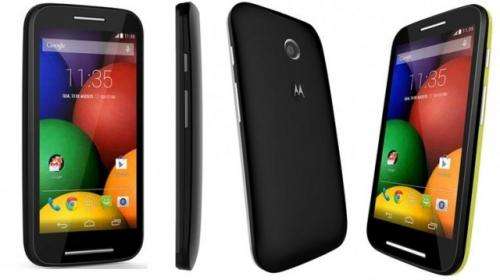Review: Motorola's new Moto E has a nice price, but lacks features

There still are lots of cellphone users here and abroad that haven't yet switched to smartphones, and Motorola is hoping to finally lure them over.
Earlier this month, the company unveiled the Moto E, the latest in its Moto series of phones. The device looks a lot like the flagship Moto X, which Motorola released last year. But it's smaller and - more important - cheaper.
The phone costs just $130. That's it. That's not the subsidized price and not what you pay if you sign a two-year contract.
You can find smartphones for less. But they're typically older models, used, manufactured by third-tier brands or run relatively unpopular operating systems like BlackBerry 10 or Windows Phone 8. None of those apply to the Moto E. This is a brand new model running the latest version of Android.
But there are other things to like about the Moto E than just its price. For one, it's well-built. Its plastic case is rounded in the back and feels solid and comfortable in the hand. Users can personalize their phones by choosing from among nine different colors for the back cover.
Another plus is the Moto E's bright and colorful display. Its resolution doesn't match that of most flagship Android devices, but it's still sharp. And while the phone is about the same size as Apple's iPhone 5c, which costs hundreds of dollars more without a contract, its screen is a bit larger.
For a device of this size, the Moto E includes a large and powerful battery. With average usage, Motorola says, the battery should last about 24 hours before needing to be recharged. With intermittent usage, it lasted several days in my tests.
As with other Motorola phones, the version of Android running on the Moto E is the stock version. You won't find any custom interfaces or annoying pre-loaded widgets. And at least on the unsubsidized version, you won't find any carrier "crapware," the seldom used apps often pre-loaded on smartphones that promote the carriers own services or those of their marketing partners.
One way Motorola is able to offer such a low-priced phone is by using a relatively underpowered processor. The Moto E has a 1.2-GHz dual-core chip from Qualcomm; by contrast many of the latest Android phones have much faster quad-core chips.
For most tasks, you're not likely to notice much difference. You can navigate through the interface without noticeable lag. Programs and Web pages load quickly. And you can play a wide variety of games.
But make no mistake about it: This is an entry-level phone. Motorola cut numerous corners to bring down the price. And many of those cost-saving choices diminish the user experience compared with other smartphones.
The Moto E doesn't have a front camera, so you can't easily use it to make video calls. Its rear camera has just a 5-megapixel resolution, which is much lower than what you'll find on higher-end devices. The problem is not so much the resolution as the quality; it shoots crummy pictures. Some of the indoor shots I took look so blurry that they could have been painted with watercolors. The outdoor pictures I took are somewhat sharper, but the colors are washed out.
While many smartphones today can access the carriers' high-speed LTE networks, the Moto E, in another cost-saving move, can only access their older 3G networks. The result is that Web pages and other data load relatively slowly when you are away from Wi-Fi hotspots.
They load faster when you are on Wi-Fi - but not as fast as on other devices. The Moto E's Wi-Fi radio only supports the often-congested frequency band used by older versions of Wi-Fi and not the less-used - and thus faster - band used in newer versions.
Also, you'll almost certainly want to buy an external memory card for the Moto E. It only comes with 4 gigabytes of built-in storage, of which only about 2.2 gigabytes is actually available. Just one or two high-quality games or a two-week's vacation worth of photos can easily exceed that amount.
And when it comes to convincing the holdouts to become smartphone users, there's one big problem the Moto E doesn't solve. What you pay for the device itself is only one part of owning a smartphone. What makes the devices so costly is the data plans you have to attach to them, which can easily bump up your monthly charges by $20 to $50 per month. Over the course of time you own the phone, that difference is going to matter a lot more than the initial cost of the device.
If you can swallow the cost of a smartphone plan, you should probably look at buying a phone with more up-to-date features than the Moto E. It's not a bad phone, but gadgets moderately more expensive will likely be more satisfying to use for a longer period of time.
WHAT: MOTOROLA MOTO E SMARTPHONE
Likes: Inexpensive. Bright and sharp screen. Includes stock version of Android. Solid-feeling. Can be personalized with a range of different colored back covers. Long-lasting battery.
Dislikes: Poor rear camera. Lacks front camera. Includes only 4-gigabytes of storage. Can't access LTE networks or 5-GHz Wi-Fi ones. Small screen for Android device.
Specs: 1.2GHz dual-core processor; 4.3-inch, 960 x 540 pixel screen; 5-megapixel rear camera.
Price: $80 with two-year contract; $130 with no contract.
Web: motorola.com
©2014 San Jose Mercury News (San Jose, Calif.)
Distributed by MCT Information Services



















